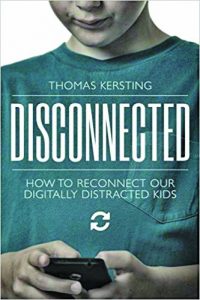Disconnected – How to Reconnect Our Digitally Distracted Kids
By Rudy Hemmann
The Surveyor
If there are children or young adults in your home, does this scenario play itself out in your household daily? One of the parents, usually the mother, calls everyone to the table for dinner. Of those who respond to the call most are absorbed in some type of handheld digital devise, either a smart phone or some sort of digital game.
There is little, or no, communication with the children, and any attempt to begin a conversation is met with angry looks from the kids.
Or how about this example: A teenage son arrives home from school, goes straight to his room, closes the door and refuses to come out, even to eat. (Hopefully he has not dropped out of school and is still attending classes. His grades have deteriorated to the point where he may flunk several classes.) 
What do these examples have in common and what, if anything, can be done to bring the kids in the situations outlined back into a more normal dynamic? Into the fray steps Thomas Kersting with his book “Disconncted.” Don’t let the longer title (shown above) deter you from reading the book. It is only 100 pages, and that includes the introduction.
He begins by giving his credentials: From 2002 until today he has been a member of the Intervention & Referral Services Committee (I&RS) at a high school where he works as a counselor. He goes on to explain, “The role of the committee is to provide academic accommodations to students with temporary or permanent disabilities as long as there is evidence the disability is affecting the student’s learning. Some common disabilities the committee has reviewed over the years include concussions, diabetes and Crohn’s disease …”
Kersting writes, “During the 2009 school year the types of disabilities referred to the committee started to change. We began receiving countless referrals for teenage students diagnosed with Attention Deficit Hyperactivity Disorder, also known as ADHD; which is a neurological condition that causes a combination of the following symptoms: inattention; disorganization and lack of focus; sometimes impulsivity and hyperactivity. These symptoms are very noticeable by age five, and the average age at diagnosis is eight years old. Strangely, the committee was receiving dozens of referrals for 14- and 15-year-olds newly diagnosed with the disorder.”
Kersting noted, as a school counselor by day and a private practice therapist by night, he had more than 20 years of experience working with ADHD children and their families, and this influx of attention-deficit teenagers wasn’t making sense to him. He wondered if it could be possible so many parents and teachers had missed spotting the ADHD symptoms for so many years? The more he thought about the phenomenon the less sense it made.
Kersting started to research the problem and found counselors at other schools were seeing the same thing. His research led him to Dr. Gary Small, professor of psychiatry and director of the UCLA Longevity Center at the Semel Institute for Neuroscience and Human Behavior. Small is one of the world’s prime innovators in science and technology, who began researching impact on the brain. He discovered “when subjects spent as little as an hour a day online the activity patterns their brains changed dramatically.” Small states, “The human brain is malleable, always changing in response to its environment.” He goes on to explain the brain is very sensitive, especially in children through their teenage years, and in some cases well into their 20s.
The result of eight or more hours per day seven days a week staring at the screens of tablets, smartphones and computers is a new brain, one that is lit up like a Christmas tree; a brain that has grown new branches so as to adapt to its new environment, cyberspace; a brain that is hyper-focused on tweets, posts and likes, and not very focused on a teacher’s lectures; a brain that is brilliant at communicating through texts and posts but struggles to communicate face-to-face. If young folks spend most of their time communicating through text messages rather than face-to-face, the brain will weed out the neural pathways necessary for becoming a good face-to-face communicator.
Here are some of Kerstings warning signs that a family member is spending too much time using any form of electronic media, including television.
Loses track of time when using electronic devices
Becomes agitated when interrupted
Prefers to spend time using electronics rather than being with friends or family in person
Does not follow time limits (established by parents)
Forms online relationships
Loss of interest in other activities
Is restless when not using a device and preoccupied with getting back on
Avoids homework/chores due to spending too much time with electronics
Sneaks on a device when no one is around and lies about it
Here are five rules every parent should follow when dealing with electronic devises.
Keep your child’s room clean of screens – This includes televisions and smartphones.
Your child’s phone is your phone – make this rule clear from the start and make certain you can demand to see their phones at any time.
No electronics at the dinner table – Dinnertime is family time.
Limit screen time for entertainment (including TV) to two hours per day – a recommendation from the Academy of American Pediatrics for children over eight years old.
Be a role model – This means spending less time with your own device and turn it off when with your children.
Be advised, some counseling sessions may be required depending on the severity of the case.
The following web addresses give more information on this topic. The first is an article from the New York Times website (nytimes.com) and the second is Thomas Kersting being interviewed by Tucker Carlson of Fox News.
https://www.nytimes.com/2018/10/26/style/phones-children-silicon-valley.html
- February, 11 2016

Local family moves in to new Habitat ...
By Angie Purdy The Surveyor Robin Fancis smiles for a photo...
- June, 30 2014

Community Calendar: June 26 – J...
june 26, 2014
- May, 12 2016

A compassionate experience
Compassion Experience gives a glimpse of what living conditions are for underdeveloped countries around the...
- March, 23 2015

BREAKING NEWS: Second Heron Pointe pe...
Town Clerk says group missed deadline to file petition By John Gardner The Surveyor Berthoud...
- December, 11 2014

Town board approves new website deve...
By Rudy Hemmann The Surveyor A public hearing regarding the request for annexation and rezone,...
- April, 05 2018

See you in the funny papers – &...
By Rudy Hemmann The Surveyor This month we will finish looking at what is arguably...

POLICEBLOTTER
Community News
Northern Water sets C-BT quota at 70% for 2024
Community News

Emotions run high during Revere Property hearing
Community News
Snowpack at 119% above normal
Community News

Karspeck to serve third term as Berthoud mayor
Community News

OPINION – No bitchin’ allowed
Community News
Roy Tripi to become principal of BHS on July 1
Community News
COMMUNITY CALENDAR:
Community Calendar – add an event
Homestead Fine Art Gallery First Fridays OPEN HOUSE
03 May 4:00 PM - 7:00 PM
Homestead Fine Art Gallery First Fridays OPEN HOUSE
07 Jun 4:00 PM - 7:00 PM
Homestead Fine Art Gallery First Fridays OPEN HOUSE
05 Jul 4:00 PM - 7:00 PM
Homestead Fine Art Gallery First Fridays OPEN HOUSE
02 Aug 4:00 PM - 7:00 PM
Homestead Fine Art Gallery First Fridays OPEN HOUSE
06 Sep 4:00 PM - 7:00 PM
Homestead Fine Art Gallery First Fridays OPEN HOUSE
04 Oct 4:00 PM - 7:00 PM

